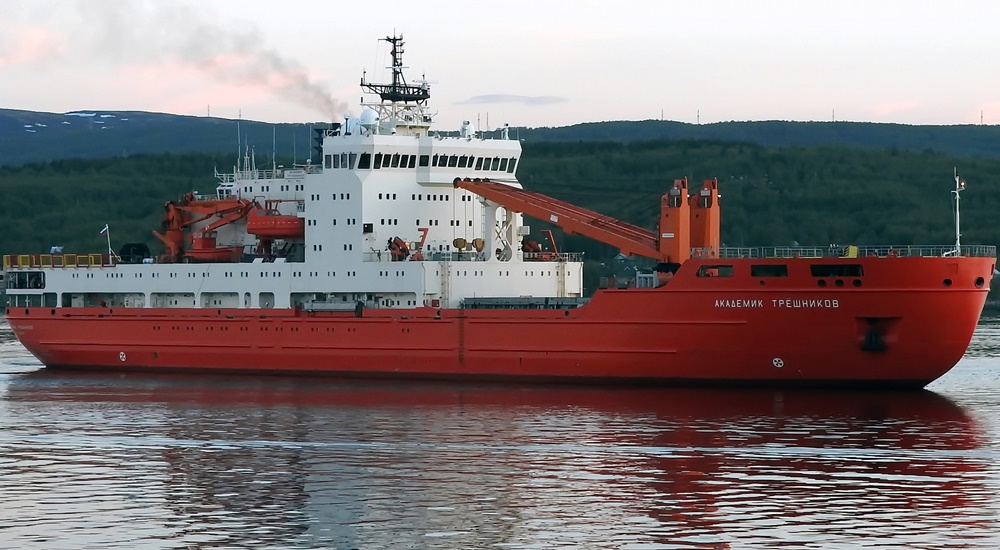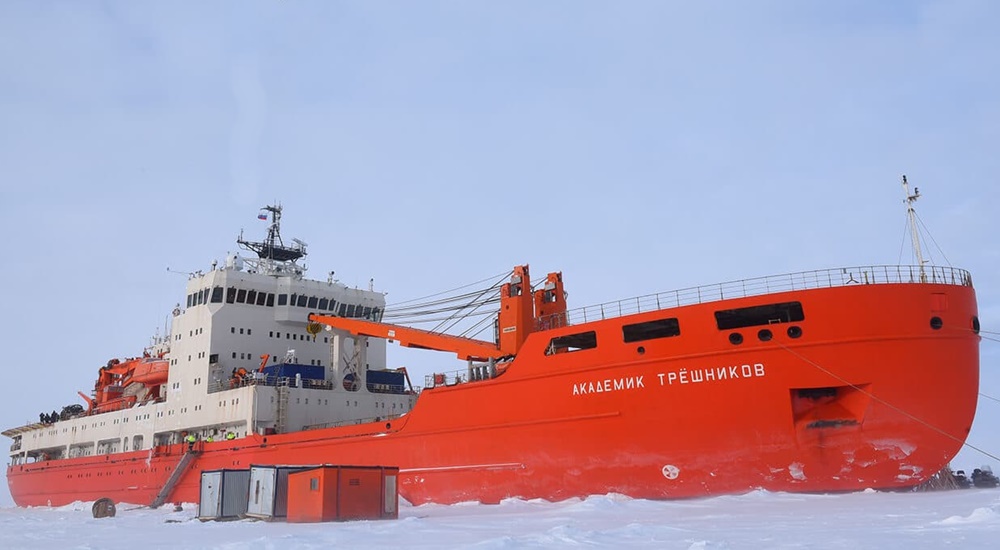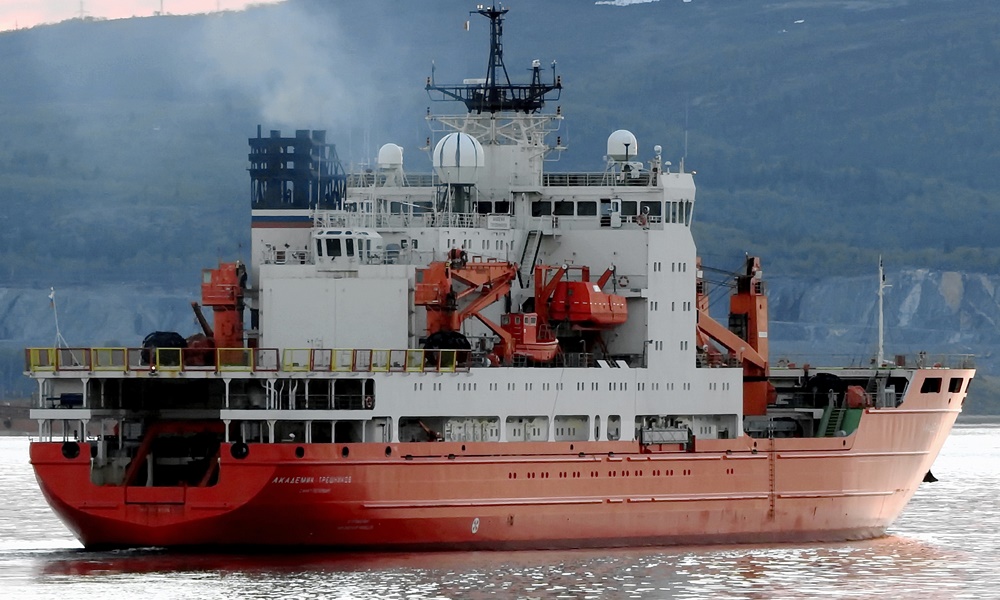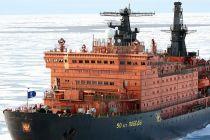Akademik Tryoshnikov icebreaker
Akademik Tryoshnikov icebreaker last position
The last location of Akademik Tryoshnikov icebreaker is in South Africa (coordinates -33.91923 S / 18.44690 E) cruising en route to CAPE TOWN. The AIS position was last reported 2 weeks ago.
Current PositionSpecifications of Akademik Tryoshnikov icebreaker
| Year of build | 2012 / Age: 13 |
| Flag state | Russia |
| Builder | JSC Admiralty Shipyards (Saint Petersburg, Russia) |
| Class | Russian icebreaker (Project 22280) |
| Ferry route / homeports | Sankt-Petersburg |
| Building cost | RUB 5 billion (USD 165M / EUR 115M) |
| Engines (power) | Wartsila (16.8 MW / 22529 hp) |
| Propulsion power | 14.2 MW / 19043 hp |
| Speed | 16 kn / 30 km/h / 18 mph |
| Length (LOA) | 134 m / 440 ft |
| Beam (width) | 23 m / 75 ft |
| Gross Tonnage | 12711 gt |
| Passengers | 80 |
| Crew | 59 |
| Decks | 7 |
| Cabins | 75 |
| Decks with cabins | 2 |
| Last Refurbishment | 2021 |
| Owner | Russian Federation |
| Operator | AARI (Arctic and Antarctic Research Institute) |
Akademik Tryoshnikov icebreaker Review
Review of Akademik Tryoshnikov icebreaker
The 2012-built RV Akademik Tryoshnikov ("ледокол Академик Трёшников") is an icebreaking research vessel (RV/корабль) owned and operated by AARI ("Arctic and Antarctic Research Institute" / "Арктический и антарктический научно-исследовательский институт", abbreviated as "ААНИИ"). AARI is based in Saint Petersburg and is the oldest and largest research institute in the Russian Federation dedicated to comprehensive studies of the Arctic and Antarctica. Another icebreaker operated by AARI is the Akademik Fyodorov (built in 1987).
The vessel (IMO number 9548536) is flagged in Russia (MMSI 273359440) and registered in Saint Petersburg.

Akademik Tryoshnikov was built by JSC Admiralty Shipyards in Saint Petersburg, Russia (Адмиралтейские верфи, part of ОСК–United Shipbuilding Corporation). The vessel was ordered on December 1, 2008. The keel was laid on June 30, 2009, and the ship was launched from drydock on March 29, 2011.
The vessel was officially delivered and commissioned on October 10, 2012. The delivery ceremony was attended by Dmitry Medvedev, who was Russia’s Prime Minister at the time.
The 5-day Baltic Sea trials took place in the Gulf of Finland (August 2012) under the command of Captain Sergey Lukyanov. The maiden voyage to Antarctica (a 111-day roundtrip itinerary) departed from Russia in December 2012 as part of the 58th Antarctic Expedition. Additional sea trials—including machinery tests, icebreaking performance, and maneuverability—were conducted near King George Island (close to Bellingshausen Base).
- In 2014, Tryoshnikov completed two Antarctic voyages—one from February to May (part of the 59th Antarctic Expedition) and another from July to October.
- In November 2016 (as part of the 62nd RAE), the vessel hosted 49 students (from Australia, France, Germany, Norway, Russia, South Africa, Switzerland, the UK, the USA, and Réunion) and 16 researchers/scientists (from South Africa, Switzerland, Russia, Australia, Italy, France, Spain, Germany, Czechia, and the UK) under the ACE (Antarctic Circumnavigation Expedition) program. It also visited Southampton, England.
- In December 2016 and January 2017, the ship visited Hobart (Tasmania, Australia), as well as the Prince Edward, Crozet, Kerguelen, and Marion Islands.
- In February 2017, the ship visited Chile’s Punta Arenas (via the Strait of Magellan), en route to South Georgia, and also called at Scott Island, Peter I Island, Baleni Island, and Stej Island.
- In March 2017, scheduled activities were conducted in the UK's South Sandwich Islands (including on South Georgia Island/Grytviken), and the vessel visited Norway’s Bouvet Island.
- In February 2022, the icebreaker supported Russkaya and Bellingshausen bases and conducted oceanographic research in the Bransfield Strait.

The Tryoshnikov icebreaker was built to support the RAE (Russian Antarctic Expedition) program (Российская Антарктическая экспедиция), delivering various cargoes and supplies (fuel, food, household goods, construction modules, building materials, scientific equipment, heavy machinery), and seasonal personnel to Russia’s Antarctic stations: Mirny (founded 1956, Queen Mary Land), Vostok (1957, Princess Elizabeth Land), Novolazarevskaya (1961, Queen Maud Land), Progress (1988, Larsemann Hills, Prydz Bay), Russkaya (1980, Marie Byrd Land), and Bellingshausen (1968, King George Island).
All voyages depart from Saint Petersburg and pass through Cape Town, South Africa.
Most drydocking and repair work is conducted in Port Bremerhaven, Germany.
Akademik Tryoshnikov vessel details
The vessel's technical design was developed by the Central Design Bureau Baltsudoproekt (ЦКБ "Балтсудопроект"). Features include a forward-located Cargo Deck, aft Helideck (helipad and hangar for two Kamov Ka-32A helicopters), laboratories, a motorized cargo barge, four heavy-lift cranes (two forward, two aft—portside and starboard), underwater ROVs (remotely operated vehicles), two Ropos submersibles, zodiacs (for expedition landings), four lifeboats, and diesel-electric propulsion (Wärtsilä powerplant, two fixed-pitch propellers, and two thrusters). The Cargo Hold can store explosive materials and includes refrigerated compartments and TEU containers on the midship Cargo Deck.

The vessel can reach a maximum speed of 16 knots (in open water) and has an icebreaking capability of 1.1 meters (3.6 feet) at a speed of 2 knots (3.7 km/h or 2.3 mph). The powerplant consists of three Wärtsilä marine diesel engines (2 x 6.3 MW and 1 x 4.2 MW), two diesel generators (0.76 MW each), and one emergency generator (0.2 MW). The propulsion system includes two thrusters (bow and stern, each rated at 7.1 MW) and two four-blade fixed-pitch propellers.
With onboard fuel and provisions, the vessel supports autonomous operations for up to 45 days and has a cruising range of 13,000 nautical miles (24,075 km / 15,000 mi).
The ship accommodates 59 crew members and 80 passengers (scientists and support personnel) in 65 staterooms, including 4 block cabins, 28 single cabins, 33 double cabins, and 10 quad cabins. Public areas include a mess hall (crew bar/restaurant), dining room, two bar lounges, two conference rooms, library, fitness room, sauna, laundry, and medical facilities (hospital, ambulatory room, surgery, dental office, and isolation room). A moon pool allows for diving operations and deployment of scientific instruments.
The ship can carry aviation fuel (657 tons), diesel fuel (735 tons), refrigerated cargo (200 tons), dry-bulk cargo (600 tons), lubricating oil (79 tons), LNG/gas (15 tons), and explosive materials (1 ton).
The scientific complex covers 150 m² (1615 ft²) and includes wet and dry oceanography labs, hydrochemical and hydrographic survey labs, a hydrometeorology lab, a computer room, and four mobile labs.
The icebreaker is named after Alexey Fyodorovich Tryoshnikov (Алексе́й Фёдорович Трёшников, 1914–1991), a Soviet polar scientist (oceanographer, geographer) and leader of the 2nd (1956) and 13th (1967–1969) Antarctic expeditions.
Note: In areas with limited AIS coverage, the vessel's current position may not be trackable. You can view CruiseMapper’s full list of icebreakers and icebreaking research ships in the “itinerary” section of our Icebreakers hub, where all participating states and their fleets are listed.
Akademik Tryoshnikov icebreaker ship related cruise news
- Cruise Industry

VIDEO: Ponant's Le Commandant Charcot meets Russia's nuclear icebreaker 50 Let Pobedy near North...
In the Russian Arctic, the 150-m icebreaking cruiser Le Commandant Charcot crossed paths with the Russian nuclear-powered icebreaker 50 Let Pobedy/50...
August 22, 2023 - show more news


